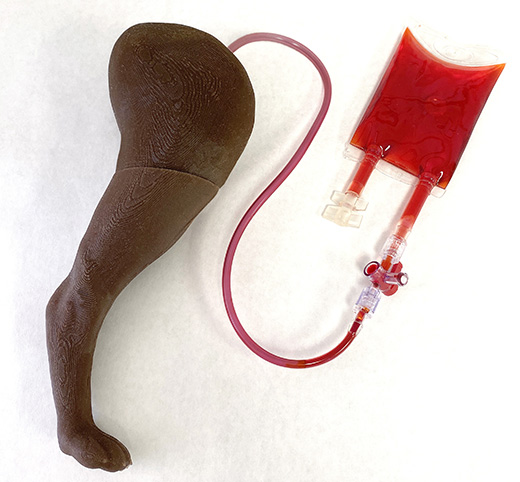K-State veterinary staffer hits model market with CHAMP
Friday, Nov. 12, 2021

The new productCHAMP: Canine Venipuncture & Injection Trainer was the idea of Kansas State University's Susan Rose, a clinical education technician. It is used in veterinary classrooms to help students learn how to handle needles and syringes properly. | Download this photo.
MANHATTAN — Veterinary students can now get a leg up on learning clinical skills thanks to a new tool envisioned by Kansas State University's Susan Rose, clinical education technician in the College of Veterinary Medicine, and commercialized with help from K-State Innovation Partners.
After recognizing a need for more accurate and robust models for veterinary teaching, one of Rose's latest models has been transformed into a product called CHAMP: Canine Venipuncture & Injection Trainer. This unique canine hind limb model was refined and produced in collaboration with REMEDY Simulation Group, a Pennsylvania-based company specializing in human/anatomical teaching models.
"CHAMP provides an opportunity for many students to learn how to handle needles and syringes properly for the first time," Rose said. "Additionally, it gives them the opportunity to develop muscle memory and hand skills they need to use traditional syringes and needles, butterfly catheters or vacutainers for obtaining blood samples, or how to insert and secure IV catheters."
Rose, who sidelines as a wildlife/nature painter and artist in her spare time, began creating models for use in K-State's veterinary courses years ago. The origins of the CHAMP began in March 2018 with her development of prototype model limbs for practicing venipuncture in junior surgery lab.
"No hind limb models were on the market for that, so I went to work to create our own," Rose said. "I modeled, molded and then cast limbs that could be used for both lateral canine and feline medical blood draws and subcutaneous injections."
In summer 2018, Ryane Englar, former clinical education coordinator at K-State and current director of veterinary skills development at the University of Arizona, assisted Rose in the search for a company that might be interested in partnering to build a model. She and Rose both saw a need for veterinary models that could hold up to heavy use in a classroom setting.
"It's one thing to create a venipuncture task trainer," Englar said. "It's another for that task trainer to hold up to 110 needle sticks without exsanguination. Model-making is just beginning to take off in the realm of veterinary education — it is still in many ways in its infancy stage — and so there are only a handful of companies that produce these products."
After partnering with K-State Innovation Partners to license the model designs in June 2018, Rose came across REMEDY Simulation Group and reached out to see if the company would be interested in entering the growing veterinary model market. After a series of meetings, REMEDY acquired the exclusive rights to two of Rose's models and the development process began.
After many more meetings and some production delays caused by the COVID-19 pandemic, the final product was released to the market on Oct. 15 in honor of Vet Tech Week.
Englar contributed feedback, an instruction booklet and a name for the model. She and her students at the University of Arizona did pilot tests of the models in their venipuncture laboratory. The models held up to over 350 needle sticks without a problem.
"I am hoping schools that do not have the ability to create their own models will invest in CHAMP," Rose said. "These are extremely helpful and valuable tools."
